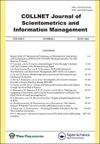Group level scientometric analysis of Pakistani authors
IF 0.8
Q2 INFORMATION SCIENCE & LIBRARY SCIENCE
COLLNET Journal of Scientometrics and Information Management
Pub Date : 2021-07-03
DOI:10.1080/09737766.2021.1960219
引用次数: 1
Abstract
The study aims to analyze the most productive Pakistani authors by using scientometric approach based on the Web of Science (WoS) data to perform group level comparative analysis. One hundred most productive authors have been recognized from ten years data of top ten universities ranked in WoS. Their publication data has been extracted for further analysis. We applied traditional metrics, h-index, h-type and composite indices. The authors have been divided into four groups, named Top Authors (N=31), Big Producers (N=18), Selective Authors (N=19) and Low Productive Authors (N=32). Descriptive and inferential statistics were performed. Findings revealed that h-index, h-type and composite indices clearly differentiate upper and lower groups. However, the discrimination between middle groups is indistinct. The functional relationship of total citations of all groups with the h-type and composite indices is found better as compared to the other traditional metrics. Total citations of top authors, selective authors and low productive authors has strong relationship with g-index and p-index except big producers. Moreover, total citations has strong relationship with h-index at top author level, moderate relation with big producers and low productive authors and poor at selective author level. The relationship of citations per publications of all groups with the h-type and composite indices was found moderate or poor except p-index. It was observed that publications counts of all groups has weak relationship with all indices. The study adds insight into the discrimination of groups of Pakistani authors using different scientometric indices. It may be of interest to those concerned in research performance evaluation metrics.巴基斯坦作者群体水平的科学计量学分析
该研究旨在利用基于科学网络(Web of Science, WoS)数据的科学计量学方法进行群体水平的比较分析,分析最高产的巴基斯坦作者。根据WoS排名前十的大学的十年数据,评选出100位最具生产力的作者。他们发表的数据已被提取出来作进一步分析。我们采用了传统指标、h指数、h型指数和复合指数。这些作者被分为“顶级作者”(31名)、“大作者”(18名)、“选择性作者”(19名)、“低作者”(32名)等4组。进行描述性和推断性统计。结果表明,h指数、h型和综合指数明显区分上下级。然而,中间群体之间的歧视并不明显。与其他传统指标相比,各类群总被引量与h型指标和复合指标之间的函数关系更好。除大型作者外,顶级作者、选择性作者和低产出作者的总被引量与g指数和p指数之间存在较强的关系。总被引量在顶级作者水平与h指数有较强的关系,与高产作者和高产作者的关系中等,与选择性作者水平的关系较差。除p指数外,各类群的出版物被引量与h型指数和综合指数的关系均为中等或较差。结果表明,各类群的出版物数量与各指标的相关性较弱。这项研究增加了对使用不同科学计量指数的巴基斯坦作者群体的歧视的洞察。它可能对那些关心研究绩效评估指标的人感兴趣。
本文章由计算机程序翻译,如有差异,请以英文原文为准。
求助全文
约1分钟内获得全文
求助全文
来源期刊

COLLNET Journal of Scientometrics and Information Management
INFORMATION SCIENCE & LIBRARY SCIENCE-
自引率
0.00%
发文量
11
 求助内容:
求助内容: 应助结果提醒方式:
应助结果提醒方式:


